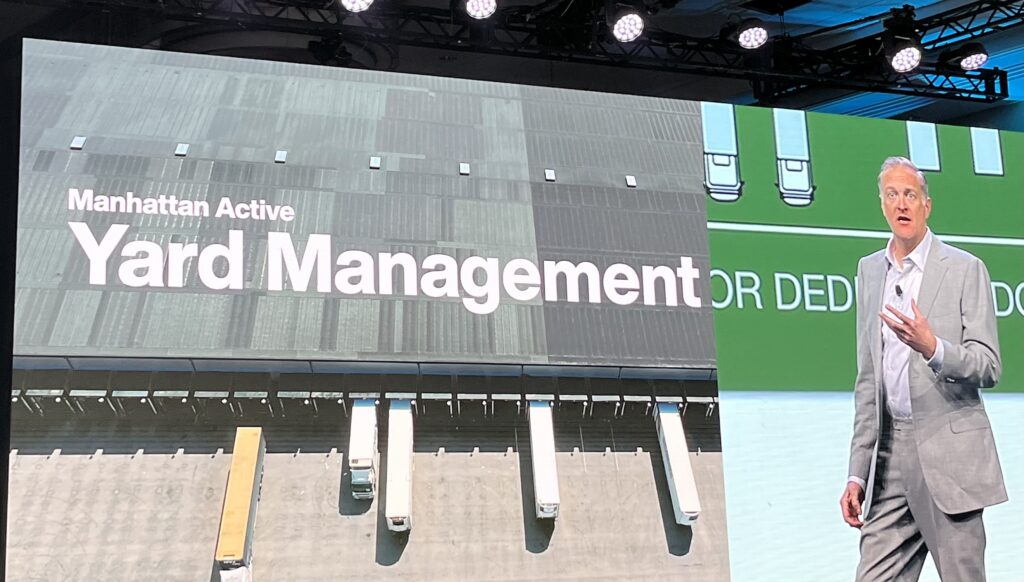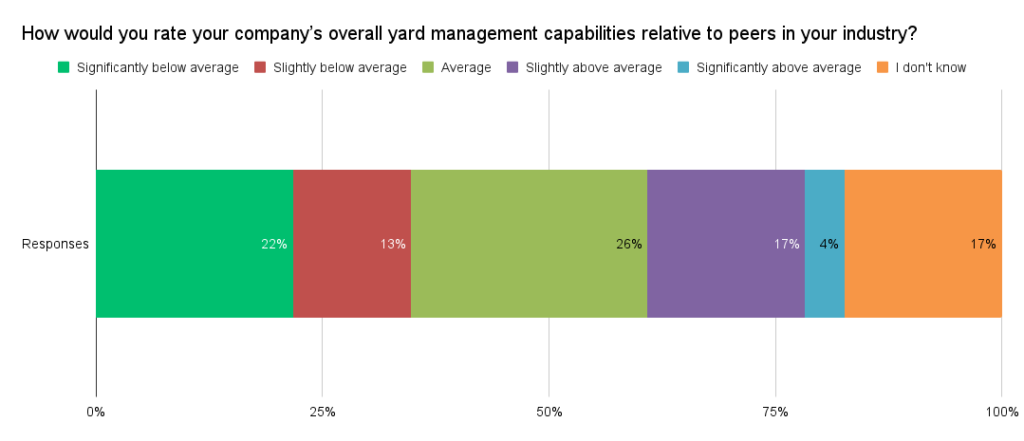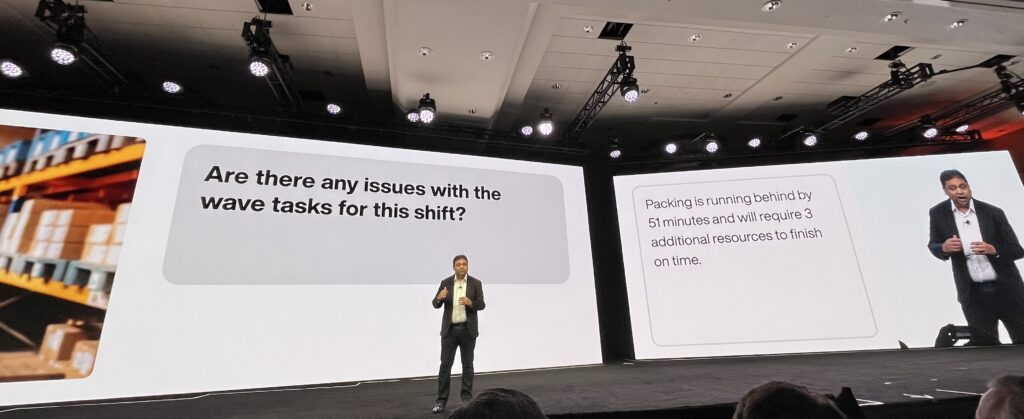Two years ago at Manhattan’s Momentum 2021 conference, the company introduced Manhattan Active Transportation Management. This wasn’t an upgrade to its previous TMS solution; it was a completely new solution, built from the ground up using the microservices architecture that underpins Manhattan’s Active technology platform. In the press release from May 2021, the company stated:
“With today’s introduction of Manhattan Active® Transportation Management to the Manhattan Active Supply Chain suite, the company has unified distribution, transportation, labor and automation within a single, cloud-native application built on Manhattan Active technology.”
This unification value proposition was a big part of last year’s Momentum conference too.
However, there was still one big missing piece, the one that I’ve called the most important limiting factor in many logistics operations today: Yard Management.
At this year’s Momentum 2023 conference, Manhattan (a Talking Logistics sponsor) finally solved for Y by introducing “its re-imagined Manhattan Active® Yard Management solution to expand the company’s vision of a unified supply chain.” Here are some excerpts from the press release:
By redesigning yard management to work seamlessly with its industry leading warehouse and transportation management solutions on a single cloud native platform, Manhattan is completing the digital unification of distribution and logistics where they come together in the physical world.
This unified approach creates optimization opportunities that aren’t possible with traditional siloed systems. The cutting-edge solution offers a digital twin representation of the yard, providing users with real-time insights and dynamic updates to help teams identify risks and opportunities quickly. This gives users clear visibility to every dock door and yard position, the trailers at each location, trailer status, the contents of those trailers, real time progress of inbound and outbound warehouse operations, as well as information related to pending arrivals and movement within the yard.
Brian Kinsella, SVP of Product Strategy at Manhattan, highlighted the new solution in his keynote presentation the first day, and the room was packed for the “Introducing Manhattan Active Yard Management” session led by Blake Coram, Director of Product Management, the next day. The message was clear: this was an important new product for both Manhattan and its customers.

Why Solving for Y Matters
Historically, yard management has been one of the weakest links in the end-to-end supply chain, with many companies still relying on clipboards or low-tech solutions to manage their operations.
In a June 2020 survey we conducted with members of our Indago supply chain research community — who are all supply chain and logistics executives from manufacturing, retail, and distribution companies — a majority of the respondents (61%) rated their overall yard management capabilities as “Average” or below relative to their industry peers, with 22% rating their capabilities “Significantly below average.”

The findings underscore the fact that many companies are average at best when it comes to yard management capabilities. As one Indago member commented, “We currently do not have a yard management system and our paper-based processes and lack of visibility make us less competitive.”
The problem is that you cannot view yard management in isolation. The inefficiencies that exist within a company’s yard have a significant impact across the supply chain, especially in transportation and warehousing operations. As a result, companies are incurring significant costs in the form of unproductive labor, higher demurrage and detention fees, lost or misplaced trailers, product spoilage, and excess inventory (among other cost factors). They are also failing to meet customer expectations around service, visibility, and responsiveness.
Of course, there are several best-of-breed YMS vendors in the market, and more recently, even some real-time transportation visibility solution providers have expanded into this space. So, where does Manhattan fit in?
In short, Manhattan is positioning its YMS as part of its overall unification value proposition — that is, since YMS is part of the cloud native, microservices-based Active platform, no additional integrations or ongoing upgrades are required. In fact, if you’re an existing Manhattan Active Warehouse Management customer, YMS is already available to you at no additional cost (there is an add-on cost if you’re just using Manhattan Active Transportation Management).
Another part of the unification value proposition is that it enables optimization based on real-time warehouse and transportation activities like put-away plans, labor, and inbound shipments. Blake Coram highlighted several key solution capabilities, which were developed based on input from four dedicated customer partners and the Manhattan Active WM product council. These capabilities include:
- Digital Twin Yard Visibility
- Complex & Composite Yards
- Transportation Aware Check-In
- Optimized Put-away Travel
- Live Trailer Interleaving
- Out of Stock Focused Trailer Utilization
- Flow-Thru Focused Trailer Utilization
- Detention and Demurrage
- Automated Pre-Receipt Allocation
- Automated Trailer and Door Assignments
A good example of the unification value proposition is Optimized Put-away Travel, which reduces labor travel times by considering optimal put-away paths during door selection. It does this by considering put-away logic, destination zones, and travel requirements from Manhattan Active WM, and real-time insights into yard trailer content from the YMS.
Are there more feature-rich YMS solutions in the market? Yes, but if you’re a Manhattan Active WM and/or Manhattan Active TM customer, this new Manhattan Active Yard Management solution goes a long way to strengthening one of the weakest links in your supply chain while also gaining the “no integrations, no upgrades” benefits of the Active platform.
—
There were many other great sessions at the conference, too many to summarize here. But I’ll share another highlight about one of the most talked about topics at supply chain conferences today: Artificial Intelligence (AI).
“The Next Programming Language Will Be English”
As I wrote recently in “Getting Started With AI In Supply Chain Management (Lessons From The Past),” despite all the hype surrounding Artificial Intelligence, relatively few companies are using AI in their supply chain or logistics operations today.
How can it actually deliver business value?
Sanjeev Siotia, Manhattan’s Chief Technology Officer, shared several examples of what’s possible when you combine a Large Language Model (e.g., ChatGPT) with OpenAPIs in his keynote presentation. In one example, not developed yet, Siotia illustrated how a distribution center manager might ask the system “Are there any issues with the wave tasks for this shift?” and the system could almost instantaneously analyze the situation and respond “Packing is running behind by 51 minutes and will require 3 additional resources to finish on time.”

The manager can then ask the system which work area currently has excess labor (in this case, picking) and then which workers currently assigned to picking are the best packers to reassign.

Can a manager do this analysis today with existing metrics and dashboards? Yes, although not as quickly. And that raises one of the biggest questions with AI today: Is the cost of using AI worth the benefit? (See recent CNBC article, “ChatGPT and generative AI are booming, but the costs can be extraordinary.”) It’s the same question that has limited the adoption of blockchain in supply chain management, and the same question that limited the adoption of RFID technology in its early days.
Simply put, AI is not cheap, so the benefits of its adoption have to greatly outweigh the costs. Put differently, if something can be done just as effectively (or good enough) today using less expensive technology, nobody will pay more to use AI.
My favorite quote from the conference also came from Siota: “The next programming language will be English” — that is, software developers and users will only need to know English (or whatever language they speak) to develop a new app or user interface. Just ask the AI and it will generate it.
What does this mean for the next generation of software developers? For the R&D teams of software companies? For users? All questions for another time.









